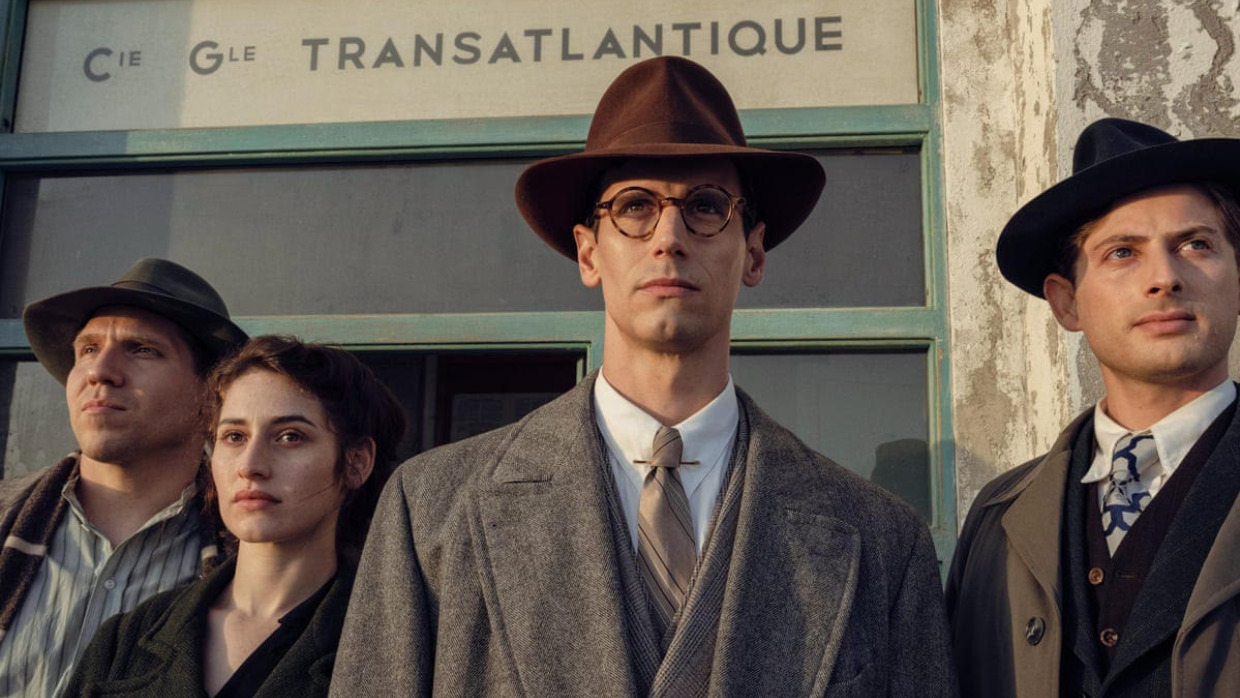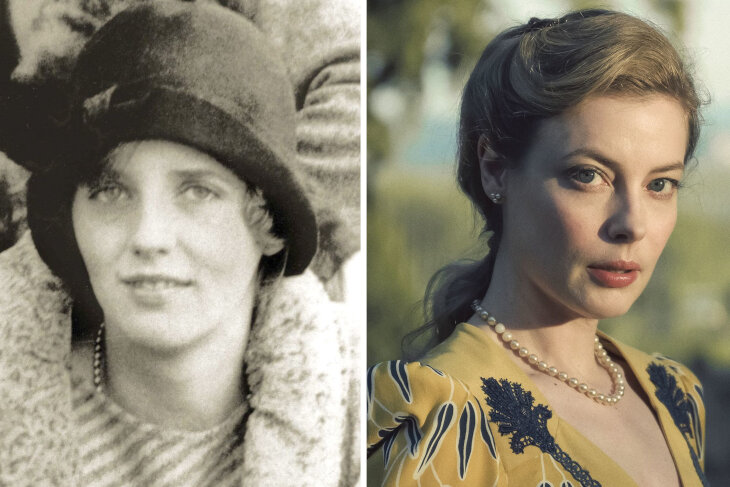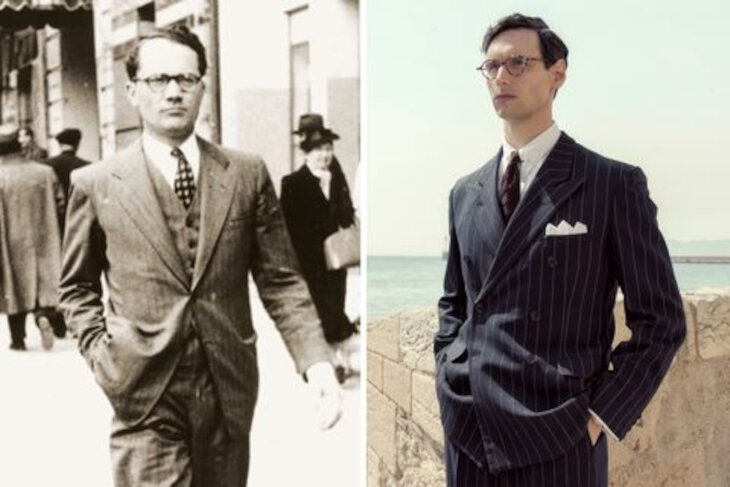 Vampire Weekend's Surprising Jewish Stories
Vampire Weekend's Surprising Jewish Stories


7 min read
The new series tells the remarkable story of the Emergency Rescue Committee that saved thousands of refugees from the Nazis.
Netflix’s new show Transatlantic tells the thrilling, true-life story of the Emergency Rescue Committee, a clandestine rescue group that saved thousands of refugees from the Nazis, including many Jews, artists, and intellectuals.
Based on the 2019 novel The Flight Portfolio by Julie Orringer, Transatlantic brings to life a host of colorful characters who set up shop in the southern French city of Marseilles in 1940, defying the Vichy French regime to lead thousands of refugees across the Pyrenees Mountains to relative safety in Spain.
One of the opening scenes captures the bravery of this motley group. Mary Jayne Gold, a wealthy heiress from Chicago, is sitting in a Marseilles cafe speaking with an American official who urges her to go back home. When Mary Jayne protests that she wants to help refugees, the official tells her she can be most useful by sending money from Chicago.
Instead, Mary Jayne spies a young Jewish refugee wandering among the cafe tables, obviously hungry. Excusing herself to powder her nose, Mary Jayne goes to the bathroom where she gives the woman food, promises to help smuggle her on a ship bound for New York, and even trades dresses with her, returning to her cafe table wearing the refugee’s dirty, sweat-stained dress.
 Chicago heiress Mary Jayne Gold (L); Gillian Jacobs who plays Gold in the Netflix series
Chicago heiress Mary Jayne Gold (L); Gillian Jacobs who plays Gold in the Netflix series
While there’s no evidence that this particular scene ever took place, Mary Jayne Gold and others risked their lives, courting arrest and death to help save thousands of lives. Transatlantic captures some of the bravery of a few of these remarkable people.
After Hitler was elected Chancellor of Germany in 1933, Jews and others began fleeing his fanatical antisemitism. Albert Einstein moved to the United States and soon joined with 50 other intellectuals to form a new branch of the International Relief Association, aimed at helping Jews and other people who were being targeted for persecution and harassment in Germany. Among the group’s early members were the philosopher John Dewey, theologian Reinhold Niebuhr, writer John Dos Passos, and Eleanor Roosevelt.
Seven years later, the International Relief Association merged with another band of intellectuals who’d gathered in New York to discuss how to best aid French refugees following Paris’ surrender to the Nazis. The two groups formed the Emergency Rescue Committee, dedicated to helping refugees in France, particularly Jews and others from elsewhere in Europe. Thousands of refugees poured into southern France, which was nominally under French (as opposed to German) control. Despite their relative safety for a time, undocumented immigrants could be arrested at any time and deported to Germany.
Varian Fry was a shy, Harvard-educated high school teacher and journalist when he became one of the Emergency Rescue Committee members in New York. He was already well aware of the terrible dangers faced by Jews in Europe: he’d reported from Berlin in 1935, where he witnessed Jews being brutally beaten up in the streets. That horror helped galvanize him to do all he could to protect Jews and others as war raged in Europe.
Fry advocated lifting America’s 1924 Immigration Act, which drastically limited the number of refugees the US was willing to take. He also wrote to Eleanor Roosevelt, begging her to find someone, “an adventurous daredevil,” to coordinate the Emergency Rescue Committee’s activities in France and “save the intended victims of Hitler’s chopping block.”
 Cory Michael Smith (R) play journalist Varian Fry (L), who was named by Yad Vashem Righteous Amongst the Gentiles
Cory Michael Smith (R) play journalist Varian Fry (L), who was named by Yad Vashem Righteous Amongst the Gentiles
Fry pointed out that he was unsuitable for this position: his French and German skills were poor and he possessed “no experience whatever in detective work.” When no one else volunteered, Fry strapped $3,000 in cash to his leg and flew from New York to France with a list of 200 Jewish intellectuals he was determined to help smuggle to safety. That number would eventually grow to over 2,000.
Much of Transatlantic takes place in Villa Air-Bel, the crumbling villa outside of Marseilles which became the International Rescue Committee’s unofficial transit center. There, Fry and his colleagues coordinated a complex network of top-secret informants and aides, who helped provide false passports and visas, shelter and aid refugees, and smuggle refugees out of France and across difficult mountain passes into Spain. The group helped pay for their passage on ships headed to America.
While most of the people the Emergency Rescue Committee aided were ordinary Jews, they also helped save the lives of a number of artists. The list of those who passed through the committee’s operations is a virtual who’s who of the 20th century’s leading artists and intellectuals: Marchel Duchamp, Jacques Lipchitz, Max Ernst, and Marc Chagall; writers Andre Breton and Heinrich Mann, Hannah Arendt and others. Alma Mahler, wife of the composer Gustav Mahler, crossed the Pyrenees, thanks to the Emergency Rescue Committee, carrying Mahler’s final work, his Symphony No. 10, with her.
Villa Air-Bel served as a haven and a home for many of these artists for a while. Painters and writers continued to work in its grounds, and each Sunday evening, Andre Breton and his wife Jaqueline hosted parties on the villa’s properties for refugees and aid workers.
In Transatlantic, the brother of the Jewish refugee that Mary Jayne Gold helps early in episode one turns out to be Albert Hirshman, a Jewish hero of the resistance who became a key agent for the group. Born in Berlin in 1915, he worked for an anti-Nazi political party in Germany before fighting in Spain’s civil war as a resistance worker in Italy. In Marseilles, Hirshman recruited new Rescue Committee members and helped coordinate routes out of France for refugees.
 Austrian actor Lucas Englander (R) plays Albert Hirschman (L)
Austrian actor Lucas Englander (R) plays Albert Hirschman (L)
He joined one of the refugee groups fleeing France in 1941 after he became known to the Vichy French authorities. Police raided Villa Bel-Air looking for him, but Hirshman escaped arrest, eventually making his way to Spain and then to the United States. He served as an Intelligence agent in the US Army, and after the war became one of America’s most prominent economists, teaching at Princeton University.
Originally from Chicago, Mary Jayne Gold was a sophisticated, multi-lingual socialite. After attending finishing school in Italy, she settled in Paris during the 1930s, throwing parties in her beautiful home and enjoying high society. When World War II broke out in 1939, all Americans were advised to leave Europe. Mary Jayne remained, determined to do all she could to help the Allies and aid refugees. She donated her personal plane to the French military, and - once she made contact with Varian Fry in 1940 - helped bankroll the Emergency Rescue Committee.
It was thanks to Mary Jayne Gold that Fry’s original list of 200 refugees expanded to over 2,000. In fact, it was called “Gold’s list,” as she identified more and more people to help. She worked as a courier and interviewer, getting to know each member of the rescue group and befriending many of the refugees she helped save.
The Emergency Rescue Committee was forced to cease operations in 1941, and Mary Jayne fled France at that time. Before she returned to the United States, she managed to smuggle vital intelligence to British agents in Lisbon.
For the remainder of the war, Mary Jayne worked to aid refugees as much as she could, and studied for a degree in criminal psychology. She eventually returned to France, settling in a villa in the Riviera. She never married. After her death in 1997, her friend, the filmmaker Pierre Sauvage, described her as “a very shrewd woman whose heart was on the right side of issues and who at a crucial turning point in history understood what was called for.” He told reporters that she “felt that only one year in her life really mattered and it was the year she spent in Marseilles.”
At a time when so many people turned away, Varian Fry, Mary Jayne Gold, Albert Hirshman and others asked themselves what they could do for others, and risked their lives to help. Their remarkable legacy deserves to be remembered.

There is also a non-fiction book, Villa Air Bel, that tells this story.
So many and yet too few whose humanity helped some to survive the bestiality of Germany's Hitler and his evil Nazi cohorts.